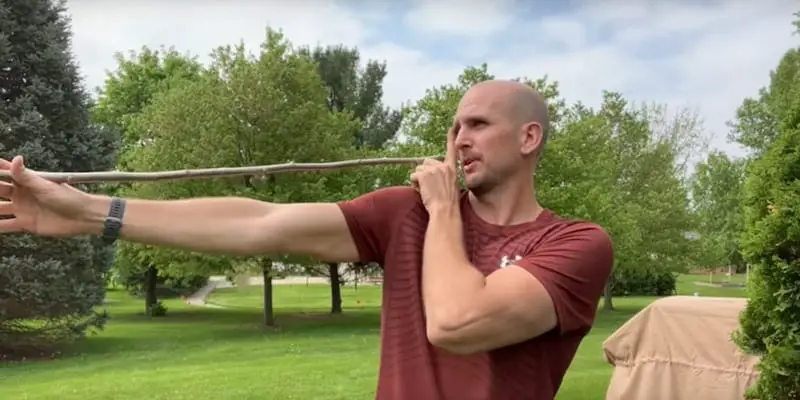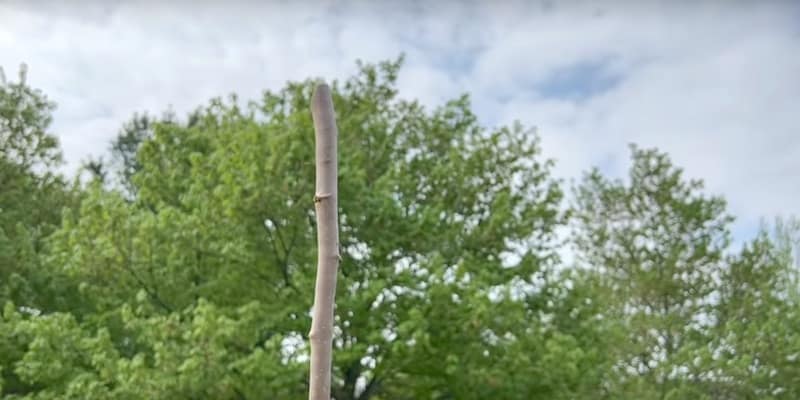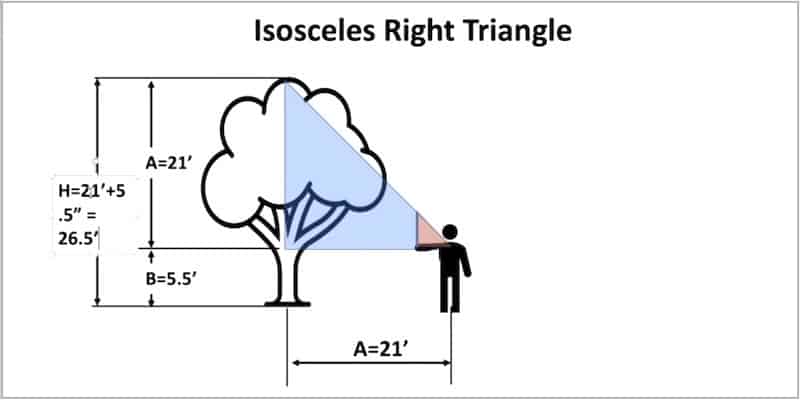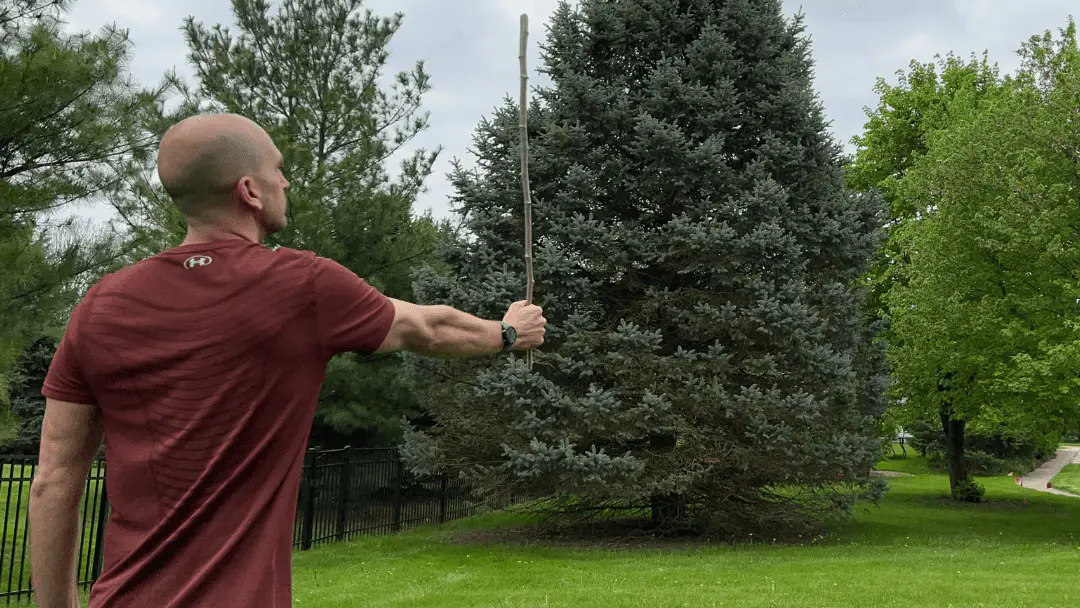In this quick tutorial, I’m going to show you how to estimate the height of a tree using only a stick. No tape measures, no laser rangefinders, no equipment of any sort.
Believe it or not, you can get pretty darn close to estimating a tree’s height by using a stick, your arm, and your eyes to implement some simple geometry.
Measuring Tree Height without a Tape Measure: Step-by-Step Guide
In this step-by-step guide, I’ll first show you this simple method of using a stick to estimate the height of a tree. Then I’ll climb the tree and measure it with a tape measure to see how close the estimate was to the actual height. Finally, for those of you who want to understand the mathematics behind the method, I’ll explain the geometric principles and why they make this kind of estimate so accurate.
This technique can be applied to other things besides trees — the height of your roof line or how high your gutters are off the ground, for example. Frankly, it can be useful for estimating the height of pretty much anything outdoors.
Rather watch than read? Check out this 5-minute video.
DISCLAIMER: This video and description contain affiliate links, which means that if you click on one of the product links, I’ll receive a small commission.
Easy Way To Estimate The Height Of A Tree: Supplies and Tools
Supplies
- A stick the length of your arm
Tools
- None! But you will need to know the length of your stride and the height of your shoulder from the ground.
Calculating the Length of Your Stride
It’s important to know the length of your stride in order for this method of estimating the height of a tree to render accurate results.
To calculate the length of your stride, mark off a distance on the ground that will allow you to walk for a good number of steps. I used 60 feet.
Once you’ve marked off the distance, walk comfortably using a consistent stride and count your steps until you get to the finish line. It took me a hair under 19 steps to cover 60 feet, which gives me pretty darn close to 3 feet per stride.
Easy Way To Estimate The Height Of A Tree: The Method
Part One
To implement this easy way of estimating the height of a tree using a stick, we obviously first need to get ourselves a stick.
The stick should be a little bit longer than your arm; long enough so that when you hold it in your hand, it spans the distance to your eye.

The accuracy of this foundational measurement will enable you to get an accurate estimate of the tree height.
Now that we have our stick, the first step is to face the tree with my arm extended and hold the stick perpendicular (in other words, at a right angle to my arm).

Then, backing away from the tree and looking over the top end of the stick, I’m going to position myself so that the top of the stick lines up with the top of the tree. This may take a little backing away and moving towards the tree to find the spot where they align.


Next, all I’m going to do is walk to the tree using my standard stride until I arrive at the base of it. In my case, it took seven steps.
Part One of my calculation is pretty basic arithmetic:
- (number of strides to tree) x (length of each stride) = distance of Part One
- 7 strides x 3 feet/stride = 21 feet for Part One of the calculation
This distance actually represents the height of the tree from the level of my extended arm to the top of the tree. This means I now need to calculate the distance from my extended arm to the ground.
Part Two
Part Two of the calculation is the distance from my extended arm to the ground. Basically, this is my shoulder height. In my case, that’s five-and-a-half feet.
Now I just add Part Two to Part One, and I have the estimate for the height of my tree:
- Part One + Part Two = estimated tree height
- 21 feet + 5.5 feet = 26.5 feet
Validating My Tree-Height Estimate
Now that I’ve done the calculation to estimate the height of this tree, I’m going to validate it by actually climbing the tree and measuring its height. (This also gives me an excuse to climb trees, which is a favorite pastime). I’m not suggesting you do this; it’s merely to illustrate that the method works.
Once I’m up in the tree, I’ll take my tape measure and measure vertically to the top of the canopy. In this instance, that’s about 9 feet up.
Then, I’ll measure from that same point down to the ground, which is about 18 feet, and add those two numbers together to get 27 feet as the measured height of the tree.
Twenty-seven feet is 6 inches off my estimate of 26.5 feet. That’s only about a 2% error, which is about as good as you could want.
Why This Method of Estimating a Tree Height Works
If you are a bit of a nerd, you will want to read on because I’m going to explain the mathematical concepts behind why this method of estimating a tree height works. If you’ve always hated math, you might want to skip this part.
We’re going to go back to the geometry lessons in school you thought you’d never use! They actually do come in handy here.
All this boils down to is a basic understanding of triangles; an isosceles right triangle, to be precise.
An isosceles right triangle has two equal sides and a 90-degree angle joining those sides. In the case of our method, these elements are represented by my arm extended horizontally to the ground and the stick I was holding perpendicular to it.
The long side of this isosceles right triangle I have “created” here is formed by my line of sight.
It’s a small isosceles triangle but as you can see in the illustration, the properties of that small, pinky-beige triangle can be extrapolated to the larger, blue triangle overlaid on the tree.

What this means is that the distance from me to the tree is the same as the distance from the level of my extended arm to the top of the tree. This is illustrated by span “A” in the diagram.
Span “B” is simply the distance of my extended arm from the ground (my shoulder height).
The total height of the tree is span A plus span B.
Easy Way To Estimate The Height Of A Tree: Conclusion
We’ve seen that this low-tech method of estimating the height of a tree with a stick is both extremely easy and surprisingly accurate.
Its usefulness is not limited to trees! The skill of creating imaginary isosceles triangles with merely your arm, a stick, and your line of sight can come in super handy as you’re planning all kinds of projects around the house.
Related Article: How to Estimate a Grade or Slope
Another useful skill for do-it-yourselfers is calculating a grade or slope for projects such as landscaping, decks, foundations, and drainage. In this video, I show you how to use a couple of stakes, some string, a bubble level, and a tape measure to calculate the elevation change in my yard.
To Leave Comments and Questions
If something doesn’t make sense or if your situation is a little different, please leave a comment under the YouTube video. I check the comments on a daily basis and am happy to help out.
Don’t forget to subscribe to our channel as we have weekly videos coming out to help you with your everyday home repairs.
We’ll catch you on the next one! Take care.




